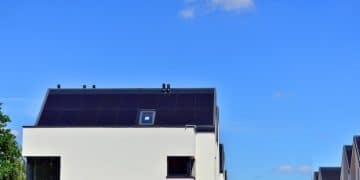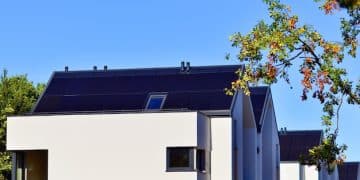Smart Window Film: How Much Can It Save On Energy Bills in 2025?

Smart window film can potentially reduce energy bills by 10-30% in 2025, depending on factors like climate, window type, and film quality, offering a promising solution for energy efficiency.
Are you wondering how much can smart window film reduce your energy bills in 2025? With rising energy costs, exploring innovative solutions like smart window film is becoming increasingly attractive for homeowners and businesses alike. Let’s dive into the potential savings and factors influencing them.
Understanding Smart Window Film and Its Energy-Saving Potential
Smart window film, also known as dynamic or switchable window film, represents a leap forward in energy efficiency technology. But how does it actually work, and what makes it so promising for reducing energy consumption?
This adaptable film adjusts its opacity in response to light and heat. This dynamic behavior allows it to regulate the amount of solar radiation entering a building, minimizing heat gain in the summer and heat loss in the winter.
The Science Behind Smart Window Film
At its core, smart window film employs technologies like electrochromics, thermochromics, or polymer dispersed liquid crystals (PDLC). Electrochromic film changes its tint when a voltage is applied, while thermochromic film reacts to temperature changes. PDLC film scatters light when unpowered and becomes transparent when an electric field is applied.
- Electrochromic Technology: Provides precise control over light and heat transmission through electronic signals.
- Thermochromic Technology: Responds automatically to temperature, reducing the need for manual adjustments.
- PDLC Technology: Offers privacy and light control, enhancing both comfort and energy efficiency.
By leveraging these technologies, smart window film effectively manages solar heat gain, reduces glare, and enhances natural light utilization, leading to lower energy bills and improved indoor comfort.
Factors Influencing Energy Bill Reduction in 2025
The actual amount you can save using smart window film will vary. Let’s consider the key factors that influence how much smart window film can reduce your energy bills in 2025.
These factors include climate, window type, film quality, installation, and how you use the film in conjunction with other energy-efficient technologies.

Climate Considerations
The climate in your region significantly impacts the potential energy savings. In hotter climates, the primary benefit is reducing solar heat gain, which decreases the load on air conditioning systems. Colder climates benefit from reduced heat loss through windows.
For instance, a home in Arizona might see greater savings during the summer months due to intense sunlight, while a home in Minnesota could save more during the winter by retaining heat indoors.
- Hot Climates: Primarily reduces air conditioning usage.
- Cold Climates: Primarily minimizes heating requirements.
- Moderate Climates: Offers a balanced reduction in both heating and cooling energy consumption.
Smart window film can be programmed to adjust seasonally, maximizing energy savings regardless of the external temperature. Effective integration of this technology depends on thoroughly understanding local climate patterns.
Estimating Potential Savings with Smart Window Film
Let’s get into some specifics. How exactly can you estimate how much smart window film can reduce your energy bills in 2025? There are several approaches you can take to calculate potential ROI.
These estimates will give you a clearer idea of how smart window film might impact your monthly expenses.
Calculating Energy Savings
Start by analyzing your current energy bills during peak seasons (summer and winter). Identify how much energy you use for heating and cooling. Next, research the energy-saving specifications of different smart window films.
Manufacturers often provide data on solar heat gain coefficient (SHGC) and U-factor, which measure how well the film blocks solar heat and insulates against heat loss, respectively.
Considering Installation Costs and ROI
Consider the installation costs, which typically range from $50 to $100 per square foot. Calculate the payback period by dividing the total installation cost by the annual energy savings.
- Assess Current Energy Usage: Look at past energy bills to establish a baseline.
- Research Film Specifications: Check the SHGC and U-factor ratings.
- Calculate Payback Period: Determine how long it will take to recoup the investment through energy savings.
Remember to factor in potential rebates or tax incentives for energy-efficient upgrades. Local utility companies and government programs often offer incentives that can significantly reduce the upfront costs.
Choosing the Right Smart Window Film for Your Needs
Selecting the best smart window film is key to maximizing savings. Not all films are created equal, so it’s essential to understand the options available and how they align with your specific needs. So consider well how much can smart window film reduce your energy bills in 2025 and make your choices according to your needs.
This involves considering factors like the type of technology used, the level of tint control, and the overall durability of the film.

Consider films with advanced features such as automated control systems that adjust tint levels based on real-time weather conditions. Also, look for films with strong warranties that protect against defects and degradation over time.
- Evaluate Different Technologies: Compare electrochromic, thermochromic, and PDLC films.
- Consider Tint Control: Determine the level of control needed for light and privacy.
- Check Warranty and Durability: Ensure the film is durable and comes with a comprehensive warranty.
Seeking advice from energy efficiency experts or conducting a professional energy audit can provide valuable insights. These experts can assess your property and recommend the most suitable smart window film for your specific requirements.
Future Trends in Smart Window Film Technology
The field of smart window film is constantly evolving, with ongoing research and development leading to innovations and improvements. Examining these trends can help prepare you for how much can smart window film reduce your energy bills in 2025.
These advances promise even greater energy savings and enhanced user experience.
Emerging Innovations
Self-powered smart window films are one of the most exciting developments. These films use transparent solar cells to generate their own electricity, eliminating the need for external power sources.
Another trend is integrating smart window film with smart home systems, allowing for seamless control through smartphones or voice assistants. This offers convenience and the ability to optimize energy usage based on real-time data.
Looking ahead, expect to see even thinner and more flexible films that can be applied to curved or irregular window surfaces, broadening their applicability to various building designs.
Installation and Maintenance Best Practices
Proper installation and ongoing maintenance are crucial for ensuring that smart window film performs optimally and delivers the promised energy savings. Careful attention to these details can significantly impact how much can smart window film reduce your energy bills in 2025.
Poor installation can lead to issues like bubbling, peeling, or uneven tinting, which can compromise the film’s effectiveness and lifespan.
Ensuring Longevity and Performance
Always hire professional installers who are certified and experienced in applying smart window film. They will ensure the film is properly aligned, free of imperfections, and securely bonded to the glass surface.
Regular cleaning with non-abrasive cleaners and soft cloths will help maintain the film’s transparency and functionality. Avoid using harsh chemicals or abrasive materials, as these can damage the film’s surface.
- Hire Certified Professionals: Ensure proper installation for optimal performance.
- Regular Cleaning: Use non-abrasive cleaners to maintain transparency.
- Avoid Harsh Chemicals: Prevent damage to the film’s surface.
Inspecting the film periodically for signs of wear or damage can help identify potential issues early on. Addressing these issues promptly can prevent them from escalating and affecting the film’s overall performance.
| Key Point | Brief Description |
|---|---|
| 💡 Energy Savings | Reduces heating & cooling costs by managing solar heat gain. |
| ☀️ Climate Impact | Savings vary based on regional climate conditions. |
| 💰 ROI Factors | Installation costs & film specs affect payback period. |
| 🛠️ Maintenance | Proper installation and cleaning maximize film lifespan. |
Frequently Asked Questions About Smart Window Film
▼
The cost of smart window film can vary widely depending on the type of film, the size of the windows, and professional installation fees. Generally, you can expect to pay between $50 to $100 per square foot for installed smart window film.
▼
While DIY installation kits are available, professional installation is highly recommended. Smart window film requires precise application to avoid bubbles, creases, and other imperfections. Professional installers also ensure proper electrical connections for electrochromic films.
▼
The lifespan of smart window film typically ranges from 10 to 15 years, provided it is properly installed and maintained. Factors such as climate, window orientation, and the quality of the film can affect its longevity.
▼
Yes, many types of smart window film offer privacy features. PDLC film, for example, can switch from transparent to opaque, providing instant privacy when needed. Electrochromic films can also be adjusted to varying levels of tint for privacy.
▼
Tax incentives and rebates for energy-efficient upgrades, including smart window film, vary by location and utility provider. Check with your local utility company and government agencies for available programs and incentives in your area.
Conclusion
In conclusion, smart window film presents a compelling solution for reducing energy bills and enhances indoor comfort. Although the exact savings can vary based on several factors, the potential benefits make it a worthwhile investment for those looking to improve energy efficiency in their homes or businesses.





